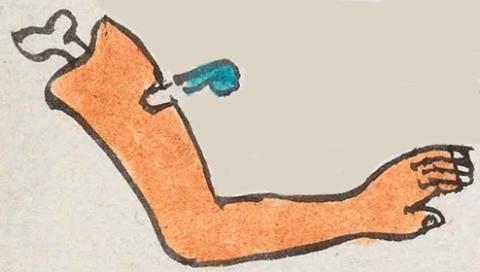Acolnahuac (Mdz17v)
In this compound glyph for the place name Acolnahuac we have two principal elements. One is the arm with a left hand (reaching to the viewer's right) and a protruding bone that references the shoulder (acolli). The bone is white, and the arm and hand are colored terracotta. The other visual is a speech scroll emerging from lips embedded in the arm. Speech or language involves the word nahuatl).
Stephanie Wood
Here, nahuatia (to give orders) or nahuatl) (speech or language) is not meant to refer literally to the language or sound, but to be a phonetic prompt for the locative suffix -nahuac, near to. Like the place name Cuauhnahuac, which refers to being near the trees or woods (cuahuitl), here, the reference to a shoulder would not be literal, but probably a phonetic clue pointing to a feature in the landscape, such as a bend in a river or a cove in a lake.
Stephanie Wood
acolnahuac. puo
Acolnahuac, pueblo
Stephanie Wood
c. 1541, or by 1553 at the latest
Stephanie Wood
language, speech, sounds, scrolls, shoulder, bones, arms, hands, idiomas, lenguas, palabras, sonidos, volutas, hombros, huesos, brazos, manos, -nahuac locative, nombres de lugares
(flagged for presentation ++)

acol(li), a shoulder, or a bend, https://nahuatl.wired-humanities.org/content/acolli
coltic, curved, bent, https://nahuatl.wired-humanities.org/content/coltic
-nahuac, near, next to, https://nahuatl.wired-humanities.org/content/nahuac
nahua(tl), speech, https://nahuatl.wired-humanities.org/content/nahuatl
nahua(tia), to give orders to someone, https://nahuatl.wired-humanities.org/content/nahuatia
-c (locative suffix), https://nahuatl.wired-humanities.org/content/c
"Adjacent to the Water-Bend"? or "Adjacent to the Acolhuah"? Karttunen notes that the locative suffix -nāhuac means "close enough to be heard clearly." She also refers to the ācōl- as possibly meaning water-bend, even though it is visually represented by a shoulder (ahcōl-). She also interprets the mouth and speech scroll as standing for the verb, nāhuatiā. [Frances Karttunen, unpublished manuscript, used here with her permission.]
"Near the Curve of the Water" (Whittaker, 2021, 68); "Beside the Shoulder" or "Beside the Acolhua" (Berdan and Anawalt, 1992, vol. 1, 169)
acol•nahua./NAHUAC
"Cerca de la Curva del Río(?)"
Stephanie Wood
Codex Mendoza, folio 17 verso, https://digital.bodleian.ox.ac.uk/objects/2fea788e-2aa2-4f08-b6d9-648c00..., image 45 of 188.
The Bodleian Libraries, University of Oxford, hold the original manuscript, the MS. Arch. Selden. A. 1. This image is published here under the UK Creative Commons, “Attribution-NonCommercial-ShareAlike 3.0 License” (CC-BY-NC-SA 3.0).





